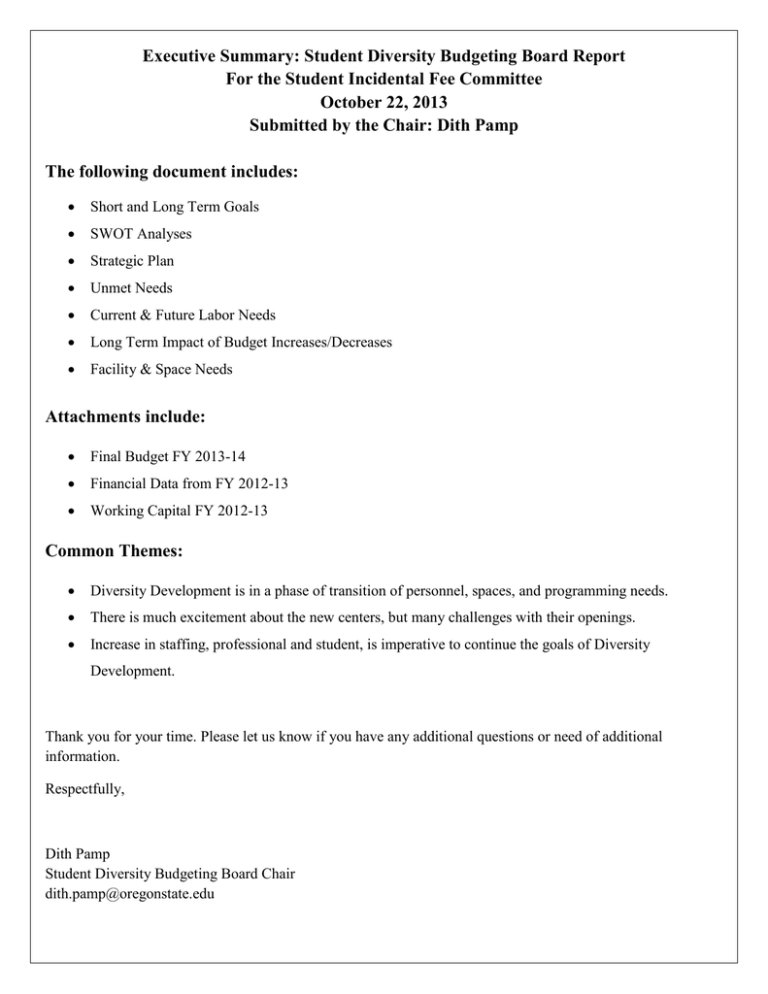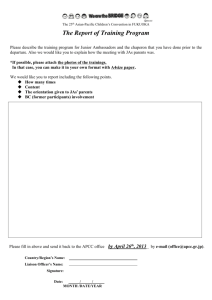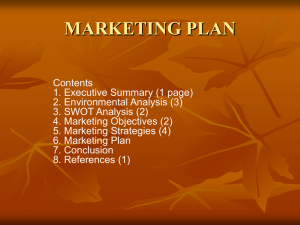Executive Summary: Student Diversity Budgeting Board Report October 22, 2013
advertisement

Executive Summary: Student Diversity Budgeting Board Report For the Student Incidental Fee Committee October 22, 2013 Submitted by the Chair: Dith Pamp The following document includes: Short and Long Term Goals SWOT Analyses Strategic Plan Unmet Needs Current & Future Labor Needs Long Term Impact of Budget Increases/Decreases Facility & Space Needs Attachments include: Final Budget FY 2013-14 Financial Data from FY 2012-13 Working Capital FY 2012-13 Common Themes: Diversity Development is in a phase of transition of personnel, spaces, and programming needs. There is much excitement about the new centers, but many challenges with their openings. Increase in staffing, professional and student, is imperative to continue the goals of Diversity Development. Thank you for your time. Please let us know if you have any additional questions or need of additional information. Respectfully, Dith Pamp Student Diversity Budgeting Board Chair dith.pamp@oregonstate.edu Diversity Development Intercultural Student Services FYE 2013-14 Executive Report for SDBB Intercultural Student Services, the umbrella organization in which Diversity Development resides, is currently under reorganization. The decision for fall of 2013 is to consolidate the four former cultural centers (Asian & Pacific Cultural Center (APCC), Lonnie B. Harris Black Cultural Center (BCC), Centro Cultural Cesar Chavez (CCCC), Native American Longhouse Eena Haws (NAL)) and the two resource centers (Women’s Center (WC) and Pride Center (PC)) under one administrative office, Diversity Development (DD). As we move forward, these centers will be call cultural resource centers (CRCs). Under the new alignment, DD will continue to serve SOL and has added administrative support to Ettihad Cultural Community (ECC) since winter of 2013. ECC is a newly sponsored student organization that aims to give voice to student body that identify with the greater Middle East. The purpose of this realignment is to streamline all administrative processes for the centers and to provide a cohesive and united platform for our historically underserved students. The alignment will strengthen cross center collaborations, increase sharing of resources, and result in better stewards of student fees. Short term goals (1-2 years) for DD: Increase educational learning outcomes with all centers’ programming Increase numbers of users coming through the centers Better outreach initiatives to increase majority of student body to centers Strengthen volunteer and internship opportunities within the centers Reconstitute centers’ advisory boards to retain diverse expertise that can support strategic goals for the centers Complete new construction of the centers DD office relocating to Student Experience Center (SEC) SOL moving into SEC Continue to build upon and strength relationships with student groups and affiliations Implement EMS reservation system for all six centers Implement keyless system to (APCC, BCC, CCCC, NAL) Creating a professional faculty position within DD to support new alignment with communication and marketing Have professional staff in place for all APCC, BCC, CCCC, NAL Streamline all centers’ policies (facility use policy, operating hours, training, hiring, catering) Complete library and complete archiving project Support OSU Alumni Association to create cultural affinity alum groups Rebranding/marketing of centers to DD and Intercultural Student Services Foster welcoming and inclusive climate for all centers Increase support and outreach to international students, non-traditional students, STEM fields Increase collaboration with academic partners and student affairs Centers to collaborate to bring out at least one well known speaker/performer per academic year Cost of living increase for student staff Increase in student staff to support new facilities Replacement of outdated computer systems and software Move ECC from student organization to SDBB budget Establish new operating budget for ECC to be at same level as the other centers when they relocate into the old APCC building (September 2014) Phase out the four graduate assistants (APCC, BCC, CCCC, NAL) by June 2014 in order to pay for professional staff (note, this is not an ideal situation but as a way to be fiscally minded in order to sustain the centers). WC and PC will be phased out in 2015. Coordinate facility needs with new custodial coordinator Begin Pride Center expansion project planning Long term goals (3-5 years) for DD: Strengthen community relationships Enhance mentorship initiatives for historically marginalized students Providing resources/training for such as scholarships, career development Implement assessments that align with Learning Goals for Graduates (LGGs) Increase retention numbers of historically underrepresented students Working with partners to support effective bridge programs Have funding available to host conferences at OSU Further enhance customer service skills within centers Create an ethos of civic engagement Create service learning opportunities within the centers Replacement of furniture Pride Center expansion project Individual SWOT analysis: Asian & Pacific Cultural Center SWOT Analysis STRENGTHS WEAKNESSES Student view: “home away from home” Physical Location – Far from residence halls/ international building, limited capacity of 30 in Staff diverse in age, gender, sexuality, race, religion, center. etc. Marketing –passive, limited to flyer distribution. Programming teaches communities about unknown aspects of Asian and Pacific islander cultures Programming includes too many food events Commitment/attention to detail among student staff Communication within the center and 18 clubs and organizations at OSU Active, experienced advisory board OPPORTUNITIES Increasing communication amongst the API Community at OSU– size and participation of APA clubs and orgs, and momentum of ISOSU as well as new Cultural Center Spreading multicultural awareness Creating student leadership opportunities with SLI Providing physical as well as soft skill resources to students and community members Utilizing more volunteers Different marketing methods: Twitter, Facebook, Instagram, etc. Increased attendance of international students Increasing First Year Experience programming (Outreach coordinator) ISS realignment means increased opportunities to collaborate with other affinity groups (WC, PC, ECC) Rebuilding of APCC: Spring Term, 2015 Becoming a venue for more events on campus, including current members of the APA council and ISOSU Becoming recognized and respected throughout the state of Oregon via OSCC (Oregon Students of Color Coalition) and other organizations THREATS Slower responses from MU facilities, emergency personnel due to location Experiencing discrimination from dominant groups based on existence of resource centers Vandalism (APCC sign) has been experienced within the past year Lack of outreach to other CRCs There is seasonal water maintenance/leakage that occurs, specifically in the basement. Centro Cultural Cesar Chavez SWOT Analysis STRENGTHS WEAKNESSES Relationship and collaborations with Latin@s Assumption that the Centro is only a place for Unidos and other organizations allows us to spend Latino/as. less money on programming, while addressing Advisory Board not very active. issues of intersectionality Temporary location may hinder ability to Temporary location: more central, accessible. support students, programming. Increases foot traffic. We don’t have a full staff as of now we are More intentional programming with outlined missing about ¼. learning outcomes. Our computers are outdated and need to be updated in the near future. Multiple staff has communicated lack of ability to stay until the end of the 2012-2013 school year. OPPORTUNITIES THREATS Outreach from campus community allows Adding the ¼ new staff might change group programming to reach non-student staff members dynamics. The original staff might already have of OSU community experiences that have made them connect on a different level. Lonnie B Harris Black Cultural Center SWOT Analysis STRENGTHS WEAKNESSES A welcoming environment to all individuals of all Losing the Graduate Teaching Assistant racial backgrounds Students are not aware of our cultural center Close knit staff within the center and the resources we provide Being able to have all types of student Students feel they have to be a part of the organizations utilize the center which establishes a Black community to utilize the resources we better relationship provide Leadership opportunities for students who want to African American students do not have an work within the OSU community invested interest in the collective community The opportunity to work with other centers and Lack of involved student leaders establish a sense of unity Malfunctioning equipment Divine Nine memorial Temporary location Autonomy Communication between Diversity Implementation of new programs Development and BCC Potentially losing the Student Lead approach OPPORTUNITIES THREATS Inform potential students about our center and Reorganization of Intercultural Student Services available resources during campus tours A misinterpretation of the values of the BCC Networking with the Black community on other from previous years campuses and surrounding cities A lower budget would equate to smaller events Maintaining the BCC website and social media and less publications First Year Live-In Experience A misinterpretation the BCC is only for Black students Having community members on the advisory board Multiple definitions of Black identity “being U-Engage Courses Black enough” Growing relationship between various departments Social conflicts within the community and community members Oregon State University’s strategic “Business Proximity (center of campus) and more diverse Model” groups of visitors being closer to INTO building Financing of education Becoming recognized and respected throughout the state of Oregon via OSCC (Oregon Students of Change of Student Affairs Vice Provost Color Coalition) and other organizations Turnover of Black Student Leaders Weakened institutional knowledge Tuition inflation Denunciation of September Scholars Native American Longhouse Eena Haws SWOT Analysis STRENGTHS WEAKNESSES Reliability of staff to help others at events ensures Limited use of funds for events restricts success of events activities that may be effective means to gain buy in by Native communities (ex. Cannot do Having a new center allows for larger events and visits to Chemawa and Tribes) more welcoming appearance Need for organizational skill building for Variety of student staff allows for larger variety of student staff related to events increases stress potential events level of students planning events Reach to target population is hard to determine as that data is not collected OPPORTUNITIES THREATS Collaborations with other programs (i.e. housing, Funding highly dependent on changing writing center, etc.) allows for potential to reach leadership within SIFC more students Continual controversy over Native identity Working with Native faculty on campus to include impacts students’ perspectives of center and its their expertise allows for strong support for center purpose as well as potential events Ability to host Tribes and other Native programs can help strengthen the relationship with them, thus making their students more likely to utilize the center SOL SWOT Analysis STRENGTHS WEAKNESSES Gaining momentum as an organization, Sol’s name Limited staff for outreach makes it difficult to is better known to the community and more reach all organizations for cross-collaborations. community members are actively engaging with Lack of specialized support resources for Sol. educational programming. The broadness of Sol’s mission allows for the engagement of a diverse spectrum of organizations. Strong foundation and developed organization branding for recognition of Sol. OPPORTUNITIES THREATS Separate Location outside the Pride Center will CRC building projects will make locations for help Sol establish a separate identity and provide a centers unavailable for a time, presenting some neutral space for collaborations between groups. barriers for collaborations and temporary facilities limits. Non-CRC organizations are a resource that has only been shallowly tapped in the past and they still present an opportunity for reaching more campus goers. Coordinators can engage in professional development opportunities in the form of attendance and holding workshops at national conferences to network and bring ideas back to Sol. Women’s Center SWOT Analysis STRENGTHS WEAKNESSES Diversity in staff members Erroneous image of center as being exclusive, not welcoming, overly feminist Commitment to creating a welcoming environment Diversity of programming OPPORTUNITIES THREATS Collaborations with other CRCs Budgeting and funding may limit Collaborations with other organizations on campus Old technology in the center Pride Center SWOT Analysis STRENGTHS WEAKNESSES Welcoming and passionate staff Location “Home away from home” Late advertising sometimes Variety of resources within the center Space insufficient size Programming (educational, social, collaborations) Miscommunication with staff sometimes In need of more comprehensive supervision Less interpersonal interaction due to size increase Less control and supervision of large staff OPPORTUNITIES THREATS New CRCs being built will allow more space for Potential outside hostility to LGBTQ+ identities larger programs University growth will exacerbate space issues University growth should increase traffic to center University growth will increase greater need of and potential leaders/staff staffing Increasing knowledge and support/acceptance for LGBTQ+ identities Strategic Plan: Diversity Development’s primary objective is to continue to support students during this year of transition as we undergo the ISS reorganization. As we phase out central ISS personnel and hire new professional staff in the cultural resource centers, there will be gaps and services that are critical to continue in order to provide ongoing support to students’ programming, resources, and co-curricular initiatives. Secondly, focus on the construction project and hiring professional staff in place to lead the new facilities. And lastly, to streamline all procedures and policy for all centers in order to effectively serve students with varying degree of needs. Unmet Needs: Currently, our unmet need is surrounding the newly funded classified position for DD. This position was initially crafted to be professional faculty to take on training and development of students in the center around marketing and social media. As we move forward with aligning all the centers under DD, it is clear that we need a comprehensive marketing plan and the ability to meet request from students for marketing/social media training. The current classified position does not allow for this demand without sacrificing administrative duties and potentially violating collective bargaining unit policy. This will continues to be a challenge unless we find a way to rectify this position classification. Current & Future Labor Needs: Currently, staffing levels within the centers have not changed since the early 2000. We have been mitigating the increased demand on staffing needs by closing down the centers before finals week and monitoring staffing hours closely that negatively effects training, and center coverage. Our future hope is to increase staffing level to appropriate level to support increasing demand from new centers and changing demographic of campus. Our goal is to increase staffing level within each center by 3-4 students’ increment. The four graduate assistantship positions in DD provided the majority of diversity opportunity for CSSA students. Since phasing these positions out in order to fund professional staff, we will need to look at addressing this issue in the future to support increasing need for graduate students to gain practical experience working with historically underrepresented students and a ways to fund their education. As central ISS phase out positions, our LGBT Outreach & Services Director will take on another role (E & G funded), thus leaving a gap to support the PC. We will need to request funding to hire a professional staff for the PC at the same level as the other centers in two years. In working with the MU to setup our reservation system, they have voiced concern around reaching maximum capacity to take on additional centers. In our strategic plan, we’ll have seven centers by the end of 2015. This will require conversation around the need for our own professional staff to management database, hardware, and event coordination. Long Term Impact of Budget Increases/Decreases: Long term impact of a zero percent increase in budgets has continued to provide substandard level of support to the student staff and facilities. The impact of underfunded budget affects each center differently as each center has different number of student organizations with different needs. Students have been put in compromising situation that could potentially be risky. For example, using personal vehicle for work related activities, skipping class to staff center, and working late alone. A budget increase will have to take effect in order to provide ECC with an operating budget that can support and sustain their own center by September 2014. Facility & Space Needs: In the next couple of years, we will need to expand and update the Pride Center. They have been working with limited programming space. This project was put off so that we can fund the construction of the other four centers. Also, once the APCC move into their new building (September 2014), the old APCC will need major updating to bring the building back up to code in order for ECC to occupy that space.


